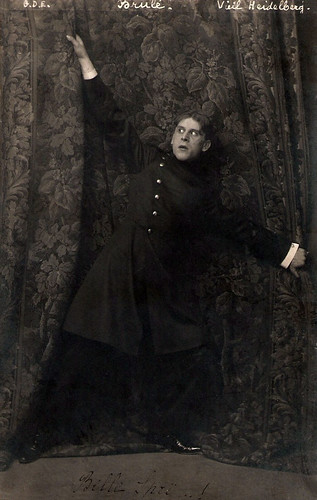
Belgian postcard by G.D.E. (G. Dupont-Emera, Rue Royale 142, Bruxelles). Photo: publicity still for the stage play 'Vieil Heidelberg' (Old Heidelberg, 1909).

Belgian postcard by G.D.E. (G. Dupont-Emera, Rue Royale 142, Bruxelles). Photo: publicity still for the stage play 'Vieil Heidelberg' (Old Heidelberg, 1909)
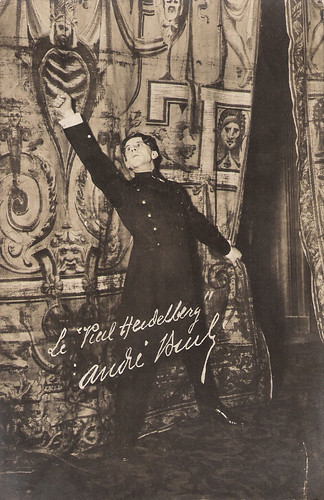
French postcard. Photo: publicity still for the stage play Vieil Heidelberg (Old Heidelberg, 1909).

Belgian postcard by G.D.E. Photo: publicity still for the stage play 'Vieil Heidelberg' (Old Heidelberg, 1909).
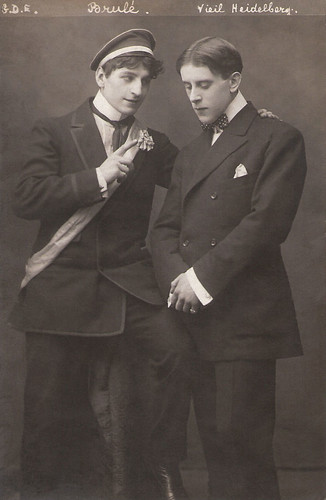
Belgian postcard by G.D.E. Photo: publicity still for the play 'Vieil Heidelberg' (Old Heidelberg, 1909). Sent by mail in Belgium in 1909.
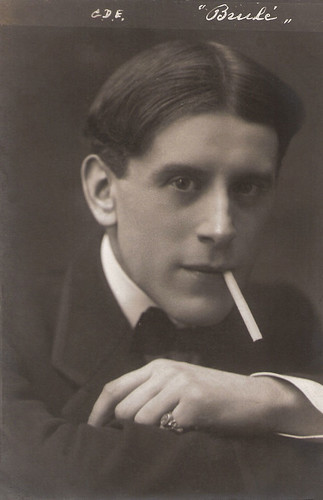
Belgian postcard by G.D.E.
Arsène Lupin
André Brulé was born as André Gresely in Bordeaux, France in 1879.
He was the first actor to impersonate the gentleman thief Arsène Lupin, the hero of the crime fiction novels written by French writer Maurice Leblanc. In Francophone countries, Lupin has enjoyed a popularity as long-lasting and considerable as Sherlock Holmes in the English-speaking world.
Brulé played the double role of Lupin and his alter ego Duc de Charmerace in the stage play 'Arsène Lupin - Nouvelles Aventures' (Arsène Lupin - New Adventures) (1908). The play was written by Francis de Croisset and Maurice Leblanc, and directed by M. Deval. It was staged at the Athenee Theatre in Paris, where Brulé had already performed successfully for several years. Opposite Brulé played Escoffier as Inspector Guerchard.
In 1909 Brulé appeared on stage in another great hit: 'Vieil Heidelberg' (Old Heidelberg). This was the French version of 'Alt Heidelberg', a popular German stage play by Wilhelm Meyer-Förster, staged in France for the first time in 1906, at the Theatre Antoine, in a translation by Maurice Remon & W. Bauer. Later it was staged a.o. at the Odeon Theatre in Paris in the seasons 1906-1907, 1907-1908, 1912-1913 and 1931-1932.
The play knew many adaptations for the cinema. John Emerson directed Old Heidelberg (1915) with Wallace Reid and Lilian Gish. Ernst Lubitsch adapted it as The Student Prince of Old Heidelberg (1927), starring Ramon Novarro and Norma Shearer. In Germany the first of several film adaptations was done by Hans Behrendt in 1923, starring Paul Hartmann and Eva May.

Belgian postcard by G.D.E. (G. Dupont-Emera, Rue Royale 142, Bruxelles).

French postcard by Théâtre de l'Athénée, Paris. Photo: publicity still for the boulevard play Coeur de Moineau (Sparrow Heart, 1905) by Louis Artus.
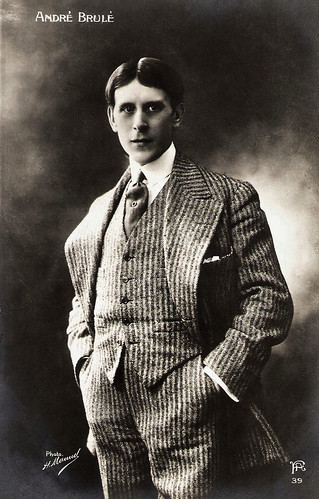
French postcard by FA, no. 39. Photo: Henri Manuel.

French postcard by FA, no. 86. Photo: Henri Manuel.

French postcard by Imp. H. Bouquet, Paris for Théâtre de l'Athénée. Photo: Henri Manuel. Publicity still for 'Le Coeur Disposé' (The Arranged Heart, 1912) by Francis de Croisset.
Thief-turned-cop
André Brulé also appeared in several films. He made his first film appearance as young Werther in the early silent short Werther (Henri Pouctal, 1912), a prestigious Pathé production based on the famous literary novel by Johann Wolfgang Goethe which is considered now lost. Other short silent films were Le club des élégants/The Elegant Club (René LePrince, 1912), and Les frères corses/The Corsican brothers (Antoine, 1917) based on the novel by Alexandre Dumas père.
Brulé returned to the screen in the late 1930s. He played such protagonists as the thief-turned-cop François-Eugene Vidocq in Vidocq (Jacques Daroy, 1938), Zoltini in Métropolitain (Maurice Cam, 1939) with Albert Préjean, and Monsieur de Nogrelles in Retour de flamme/The Flame Returns (Henri Fescourt, 1943). Probably his most interesting film of this period was Les gens du voyage/People Who Travel (Jacques Feyder, 1938) in which he appeared as Fernand opposite Françoise Rosay as a middle-aged lion-tamer.
At Films de France, James Travers reviews: "What is perhaps most striking about Les Gens du voyage is how fresh and modern the film still feels. This is partly due to its daring mix of cinematic styles, reflecting the rapid evolution of cinema in the late 1930s. The liberal use of location filming gives the film a neo-realist feel in places; the plot is a mix of melodrama and policier; and elements of early film noir and poetic realism are also noticeable. Some engaging comic touches provide a pleasing contrast to the film's darker moments, without undermining the dramatic content. What is surprising, and what is surely a sign of its director’s genius, is the way in which Feyder manages to combine all these different styles and themes and delivers a work that is cohesive and satisfying."
On stage, Brulé appeared among many, many more in 'L'Épervier' (1914) by Francis de Croisset at the Théâtre de l'Ambigu, 'Le Vertige' (1914) by Charles Méré at the Théâtre de Paris and 'Les Monstres sacrés' (1940) by Jean Cocteau at the Théâtre Michel.
André Brulé died in Paris, in 1953. He was married to French comedy actress Ghislaine Dommanget, but the couple later divorced and she remarried with Louis II, Prince of Monaco.

Belgian postcard by G.D.E. Photo: publicity still for the stage play Arsène Lupin - Nouvelles Aventures (Arsène Lupin - New Adventures, 1908).

Belgian postcard by G.D.E.
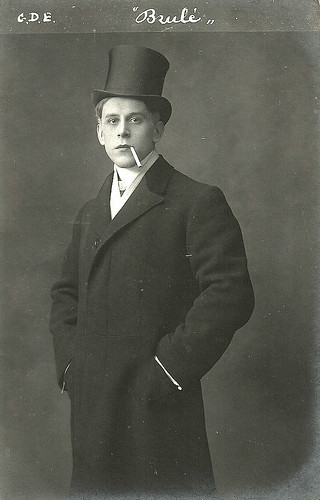
Belgian postcard by G.D.E.
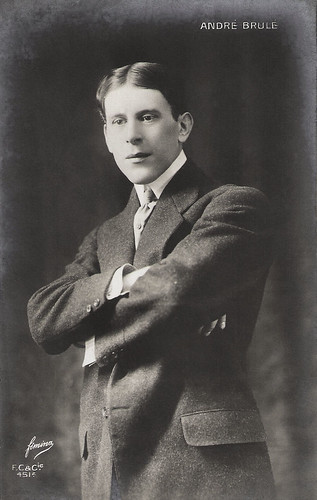
French postcard by F.C. & Cie, no. 451a. Photo: Fémina.

French postcard by A.N., Paris in the Les Vedettes de Cinéma series, no. 95. Photo: G.L. Manuel Frères.
Sources: James Travers (French Films), Hal Erickson (AllMovie), Wikipedia and IMDb.
This post was last updated on 19 August 2023.
No comments:
Post a Comment